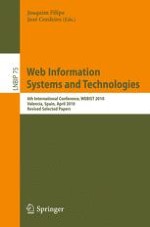This book contains the thoroughly refereed and revised best papers from the 6th International Conference on Web Information Systems and Technologies, WEBIST 2010, held in Valencia, Spain, in April 2010, organized by the Institute for Systems and Technologies of Information, Control and Communication (INSTICC), in collaboration with ACM SIGMIS and co-sponsored by the Workflow Management Coalition (WFMC).
The 21 papers presented in this book were carefully reviewed and selected from 205 submissions. The papers are grouped into four parts on Internet Technology; Web Interfaces and Applications; Society, e-Business, and e-Government; and Web Intelligence.
